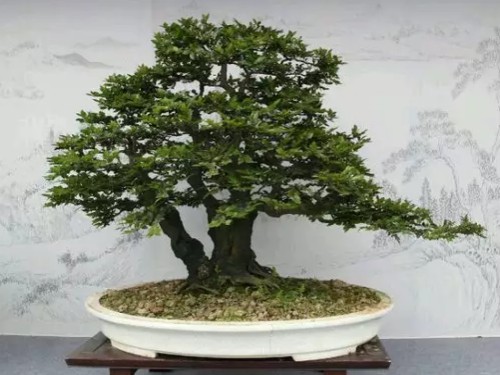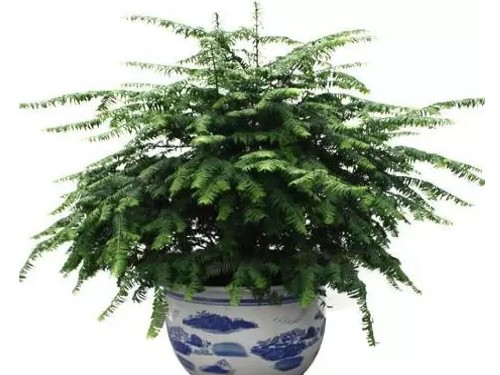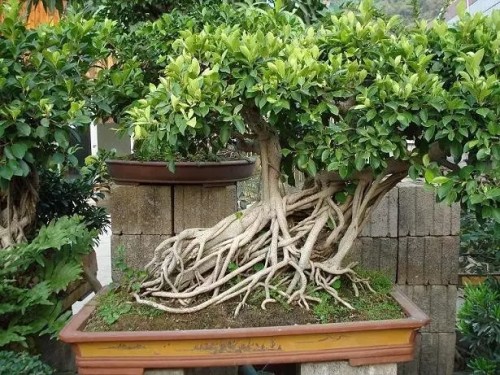How to maintain the bonsai of black bone tea
Black bone tea, also known as black sandalwood, is a unique tree species near Jiangmen Taishan and Yangjiang in Guangdong Province. it is a newly excavated bonsai tree species in the past decade, because of its small growth range, slow growth, easy to take care of, and artificial cultivation. Scarcity is precious, and people pay attention to it. Bonsai of black bone tea has gradually become a new fashion in bonsai industry.
The aroma of black bone tea is beneficial to human heart, liver, kidney and other functions, can effectively stabilize human brain waves to make emotional balance, serenity, calmness, help sleep, but also help meditation benefits. Black bone tea burning will emit a quiet fragrance, the essential elements contain germicidal benefits, but also have a calming and calming effect. Black bone tea is black in color, compact in texture, elegant and long in fragrance, and solemn in decoration. Buddhism believes that sandalwood has the effect of expelling evil spirits.

Black bone incense is mainly a bonsai tree species dominated by viewing leaves. The leaves of black bone tea bonsai are relatively small and dark green, its bark and roots are black, and its wood is very hard, but its growth rate is very slow. Shaped big tree-shaped works have only been seen in bonsai magazines in Taiwan. Don't worry. Let's take a look at its maintenance methods.
The growth of black bone tea is very slow. It is also the slowest growing tree species in Lingnan bonsai, and it grows more slowly than boxwood, so we should pay special attention to selecting stumps with young branches. If its cut is more than 3 cm, it will be very difficult to cultivate a matching branch support. Of course, the best time to dig black bone tea is after the Spring Equinox and before Grain in Beard.
Black bone tea has strong sprouting power and fast rooting, so basically dry, support and root can be cut in place at one time. After the stump is cut off, it can be soaked in clear water for 24 hours and then planted with river sand, and then placed in a semi-shaded place to keep it dry and humid. then after 20 days, he can see the secretion of black liquid in his section, and he can sprout in a few days, and the new root can be seen in 60 days, so its survival rate is very high.
After the black bone tea has survived, it can be transferred to a ventilated place in Dangyang, and light fertilizer and water can be applied to it, so that the roots and branches can be strengthened, and after the Autumn Equinox, it can be fixed according to its shape. Cut off all the unnecessary branches so that its nutrients can be concentrated on the modeling branches. After growing up, the root system of black bone tea likes fertilizer very much. As a result, we can appropriately increase fertilizer for it, basin noodles need us to apply rotten farm manure for a long time, so that every time it is drenched in water, its nutrients can be slowly dissolved, which is more conducive to the absorption of tree stumps.
When drenched with water, we must achieve the principle of being dry and wet, not dry and wet, and drenched through. After Lesser Snow, we should stop fertilization and complete the management of a growth cycle. What is worth our attention is that within the whole growth cycle, it should not appear the phenomenon of slow growth because of the shortage of fertilizer and water. Such a management ability is the best kind of management.
Black bone tea is characterized by fine green leaves and its name because of its black stalk. It is very beautiful when it sprouts in March and April. It is easy to take care of after the bonsai is shaped, and it can be trimmed once or twice a year.
Black bone tea is an evergreen type of bonsai in four seasons, and it can sprout new shoots every season. Therefore, dynamic pruning can be carried out all the year round, and each pruning can only be carried out after the new shoots are ripe, but it is still best in spring and autumn. Black bone tea is not easy to lose branches, so it can be pruned on a single branch. After sprouting, strong buds should be left. If new buds are allowed to grow freely, it is difficult to meet the requirements of spreading branches. This must be paid attention to.
Black bone tea compared with other plants, its roots are relatively rough, generally can be cut in place at one time, but its best time to dig before and after spring, because at that time the roots may be relatively better to dig. Its survival rate is very high. The wound you cut will have mucus after more than 20 days. After these days, it will begin to sprout and then grow new roots, but it grows very slowly. We all know that yellow poplar grows very slowly, right? he grows slower than yellow poplar.
Even if the black bone tea grows slowly, we still have to trim it from time to time for its beauty. New buds grow up after pruning, and if you want it to grow in all directions, you need to use wire to bend the new buds. As for the shape you want, it depends on how your wire develops with the buds.
If the black bone tea survives, let's move it to a sunny place and don't fertilize it too much, not too thick, just a little lighter. However, if the roots of black bone tea become bigger and harder, then we can increase the efforts of fertilization, but we should sprinkle the water on the top, disperse the fertility, and get wet thoroughly, but it is best not to get very wet in cloudy and rainy weather, because the roots may become moldy.
In addition to the above, I suggest that the soil in the bonsai of black bone tea should be changed every five years, which is of great benefit to the growth of black bone tea bonsai. If you feel that the black bone tea bonsai doesn't fit your aesthetic, you can create a shape you like by yourself. And in the growth process of black bone tea bonsai, if you want to make it have a unique shape, you can use iron wire to bind, play a certain role in shaping.
Time: 2019-06-01 Click:
- Prev

How to raise yew bonsai
Taxus is an ancient tree species with a history of one hundred years. It has a long history of cultivation in China and is deeply loved by people. Taxus has very strong medicinal value, which can extract paclitaxel. It is internationally recognized as an anti-cancer and anti-cancer drug, and it is a national first-class protected tree species. It is named because the red bean of the yew has the same fruit as the red bean.
- Next

How to preserve the bonsai of small leaf banyan
Small-leaf banyan is a common plant in the south, which has thick aerial roots like all banyan plants. These gas roots are very elegant, like hanging curtains, but they are firmly directed at the land, and the feel is not soft and smooth but full of strength. Once buried, they can grow roots and support the continuous extension of the tree crown.
Related
- Fuxing push coffee new agricultural production and marketing class: lack of small-scale processing plants
- Jujube rice field leisure farm deep ploughing Yilan for five years to create a space for organic food and play
- Nongyu Farm-A trial of organic papaya for brave women with advanced technology
- Four points for attention in the prevention and control of diseases and insect pests of edible fungi
- How to add nutrient solution to Edible Fungi
- Is there any good way to control edible fungus mites?
- Open Inoculation Technology of Edible Fungi
- Is there any clever way to use fertilizer for edible fungus in winter?
- What agents are used to kill the pathogens of edible fungi in the mushroom shed?
- Rapid drying of Edible Fungi

